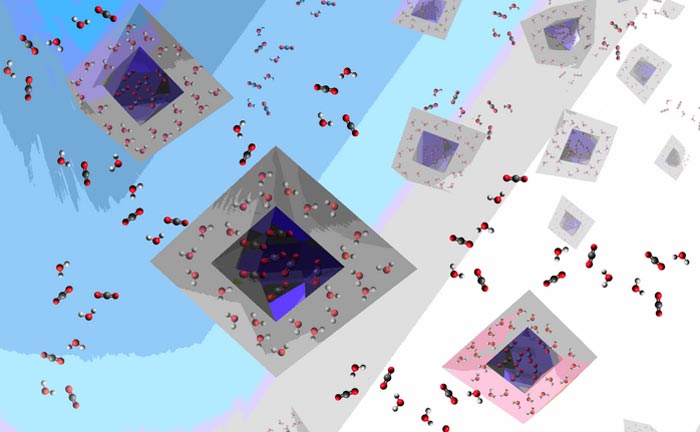Getting it to stick: Grabbing CO2 out of the air

The MOF would have a core-shell design, meaning carbon dioxide would be trapped in the core, while the shell is able to block other gasses, specifically water. The shell and the core would be made from different MOF materials, with the shell MOF designed to slow down water and the core MOF designed to bind CO2.
Credit: The University of Pittsburgh
Direct air capture may be key to saving Earth from the effects of climate change, but there’s a catch: It’s really hard to do.
Direct air capture (DAC) technologies are designed to remove carbon dioxide from the air, although there’s still a lot of room for improvement in DAC materials. Other molecules in the air, especially water, are in much higher concentrations than carbon dioxide, or CO2. They start competing with each other, and ultimately, carbon dioxide isn’t what’s caught – at least in high quantities.
“If materials are good at grabbing carbon dioxide, they’re usually good at grabbing multiple gasses,” explained Katherine Hornbostel, assistant professor of mechanical engineering and materials science at the University of Pittsburgh Swanson School of Engineering. “It’s really hard to tune these materials to grab carbon dioxide but nothing else, and that’s what this research is focused on.”
Hornbostel is joined by co-investigators Nathaniel Rosi, a Pitt chemistry professor with a secondary appointment in the Swanson School and Christopher E. Wilmer, associate professor of chemical and petroleum engineering and William Kepler Whiteford Faculty Fellow in the Swanson School. Janice Steckel, a research scientist at the National Energy Technology Laboratory, and graduate students Paul Boone, Austin Lieber and Yiwen He will also be working on the project. Together, they published a journal paper for the Royal Society of Chemistry about creating new metal-organic frameworks, or MOFs, designed to capture just carbon dioxide.
MOFs, a research focus in Wilmer’s lab, are highly regarded for their ability to utilize porous membranes to capture large volumes of gasses and can be designed via computational modeling rather than traditional trial-and-error.
The MOF would have a core-shell design, meaning carbon dioxide would be trapped in the core, while the shell is able to block other gasses, specifically water. The shell and the core would be made from different MOF materials, with the shell MOF designed to slow down water and the core MOF designed to bind CO2.
“If you’re trying to work with an adhesive, it can be hard to come up with something that’s sticky to one material that’s not also sticky to the other material, and that’s true all the way down to the molecular scale,” Wilmer said. “So, when we make a material that’s very sticky to carbon dioxide, inadvertently, it’s usually also sticky to water. We’re trying to find a way to shield those sticky surfaces from water.”
Currently, the group is using computational modeling to weed through candidates for the best materials for both the MOF’s core and shell.
Research into direct air capture is still early in development, but already there are multiple potential uses for these technologies. According to Hornbostel, some in the field propose massive installations in unoccupied areas, while others prefer using existing infrastructure where steam and electricity are already available. But either way, for this technology to work, there needs to be a lot of moving air – which could potentially be anywhere.
Researchers have long-term plans for direct air capture outside of reversing the effects of climate change. This technology can also aid in space exploration as well as living on other planets.
“When we’re on other planets, like Mars, direct air capture is how we get fuel to return to Earth,” Wilmer said. “Every technology we design pushes the ball forward.”
The paper, titled “Designing optimal core-shell MOFs for direct air capture,” (DOI: 10.1039/D2NR03177A) was published in the journal Nanoscale.
DOI: 10.1039/D2NR03177A
Method of Research: Meta-analysis
Media Contact
Paul Kovach
University of Pittsburgh
paulkovach@pitt.edu
All latest news from the category: Interdisciplinary Research
News and developments from the field of interdisciplinary research.
Among other topics, you can find stimulating reports and articles related to microsystems, emotions research, futures research and stratospheric research.
Newest articles
Faster, more energy-efficient way to manufacture an industrially important chemical
Zirconium combined with silicon nitride enhances the conversion of propane — present in natural gas — needed to create in-demand plastic, polypropylene. Polypropylene is a common type of plastic found…

Energy planning in Ghana as a role model for the world
Improving the resilience of energy systems in the Global South. What criteria should we use to better plan for resilient energy systems? How do socio-economic, technical and climate change related…

Artificial blood vessels could improve heart bypass outcomes
Artificial blood vessels could improve heart bypass outcomes. 3D-printed blood vessels, which closely mimic the properties of human veins, could transform the treatment of cardiovascular diseases. Strong, flexible, gel-like tubes…





















